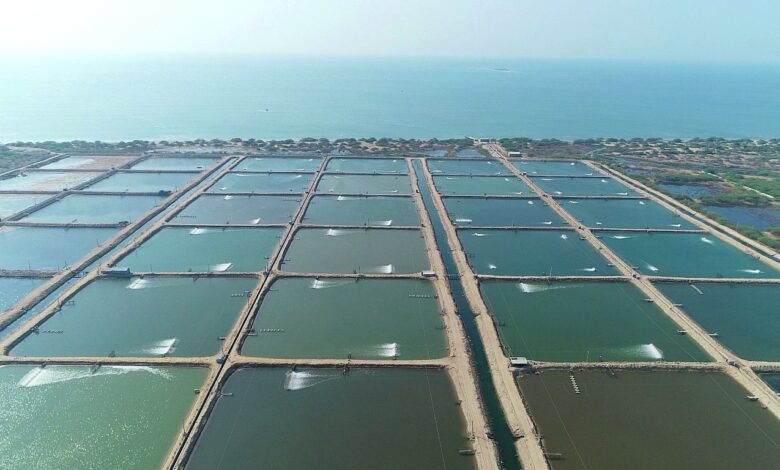Emerging technologies in Indian aquaculture: A blueprint for sustainable growth

GUEST COLUMN
 Shaji Baby John
Shaji Baby John
India’s aquaculture sector stands at a pivotal juncture. As the third-largest fish producer globally and a powerhouse in shrimp exports, India has the unique opportunity—and responsibility—to lead a transformation toward sustainable, technology-driven aquaculture. With growing concerns around climate change, resource scarcity and traceability, the sector is shifting from traditional methods to innovations that prioritise efficiency, transparency and environmental stewardship.
One would like to dwell here on the critical technologies shaping the future of Indian aquaculture, culminating in a pioneering initiative by us that seeks to integrate all these innovations into one scalable, collaborative model.
Recirculating Aquaculture Systems (RAS)
RAS enables intensive fish and shrimp farming in closed-loop systems with minimal water use and enhanced biosecurity. It’s especially suitable for peri-urban and land-constrained regions across India. Supported by government schemes such as the Pradhan Mantri Matsya Sampada Yojana (PMMSY), modular RAS farms are being adopted in states like Tamil Nadu, Punjab and Maharashtra. The future of RAS lies in integrating renewable energy, advanced filtration and AI-based water quality management to ensure sustainable and consistent production.
Biofloc Technology (BFT)
Biofloc systems promote microbial conversion of waste into biomass, reducing water exchange and input costs. BFT is widely promoted in eastern and southern states, particularly for smallholder and youth-led ventures. However, its success hinges on precise control and high energy efficiency. Integrating low-cost aeration solutions and sensor-based management can make BFT more sustainable and scalable, helping democratise aquaculture access for India’s rural entrepreneurs.
AI, IoT & precision aquaculture
Digitalisation is at the core of next-generation aquaculture. IoT devices monitor real-time parameters such as temperature, pH, ammonia and dissolved oxygen, while AI algorithms automate feeding, predict stress patterns, and issue early disease alerts.
Several Indian startups and research organisations are creating affordable smart kits tailored to Indian farming conditions. These systems are not just tools—they are enablers of consistent production, improved traceability and lower ecological impact.
Genomics & breeding innovation
Genetic improvement programmes are gaining momentum with institutions like ICAR-CIFA and CMFRI leading selective breeding of major Indian carps and shrimp. Genomic tools are being used to identify disease resistance, growth performance, and salinity tolerance. Going forward, the ethical application of genome editing and molecular diagnostics will play a key role in developing climate-resilient and high-performance aquaculture species for Indian farmers.
Sustainable feed and circular bioeconomy
Feed is the most resource-intensive component of aquaculture, often contributing over 60 per cent of production costs. Indian innovators are exploring alternative feed sources such as insect meal, algal protein, and single-cell biomass to reduce reliance on fishmeal and soy. Furthermore, circular models that reuse aquaculture sludge for composting or energy generation are emerging. These innovations are critical for building a circular blue economy that minimises waste and maximises value.
ESG & sustainability in aquaculture
As global seafood markets increasingly demand Environmental, Social, Governance (ESG) compliance, Indian aquaculture must align with sustainability benchmarks. Responsible water management, energy efficiency, ethical labour practices and biodiversity protection are now integral to market access and investor interest. Certification schemes (like ASC, BAP), carbon footprint tracking and transparent supply chains will soon be non-negotiable. Forward-looking farms are adopting solar energy, biodegradable pond liners, and data-backed water usage metrics to build ESG-compliant operations. Indian aquaculture must also address climate resilience. Rising temperatures, erratic rainfall, and saline intrusion are impacting productivity. Integration of weather-linked farm planning, climate-resistant species, and community insurance mechanisms are becoming essential tools for risk mitigation. By embedding ESG at the core, India can not only meet global demand but also protect the ecosystems and communities that support aquaculture.
Robotics and automation
Automation tools like smart feeders, underwater drones, and AI-based surveillance cameras are making their way into Indian shrimp farms. These systems improve efficiency, reduce manual errors, and enhance biosecurity. As domestic production of aquatech hardware grows, such tools will become affordable for mid-sized farms. Bundled with service-based models or cooperatives, automation could redefine farm economics and labour dynamics in the years ahead.
Indoor precision aquaculture and the Kings Maritech Eco Park
The convergence of these innovations finds expression in indoor precision aquaculture—a controlled, climate-independent, and resource-optimised farming model. We are currently in the process of establishing a pioneering indoor aquaculture facility under its subsidiary, Kings Maritech. Once operational, this facility will represent a national model for high-density, AI-driven and biosecure aquaculture. It will integrate smart RAS systems, IoT-enabled control panels, automated feeding and real-time traceability—delivering year-round, export-grade production with minimal environmental impact.
More importantly, the eco park is designed as a collaborative innovation platform. We welcome partnerships with technology firms, research institutions, and startups to co-develop, test, and demonstrate emerging aquaculture solutions in a real-world setting. Whether it’s AI-enabled disease diagnostics, low-footprint feeds, or blockchain traceability, the facility will serve as a living lab for sustainable aquatech innovation. Through this initiative, one aims to catalyse a new era of responsible aquaculture—one that places India at the forefront of global ESG-compliant, tech-enabled seafood production.
·The road ahead
India’s aquaculture growth must be anchored in sustainability, inclusivity and innovation. The sector holds immense potential—not just in economic terms, but in shaping a blue economy that is regenerative and future-proof. With enabling policies, private investment, and collaborative R&D, India can emerge as a global hub for aquaculture innovation. In doing so, we not only feed the world but also lead it—ethically, intelligently and sustainably.
(The author is the chairman and managing director of Kings Infra Ventures Limited who also writes on the blue economy and sustainable food production system; views are personal)






